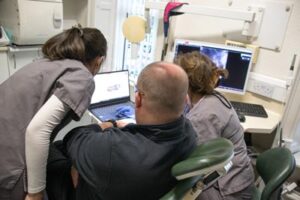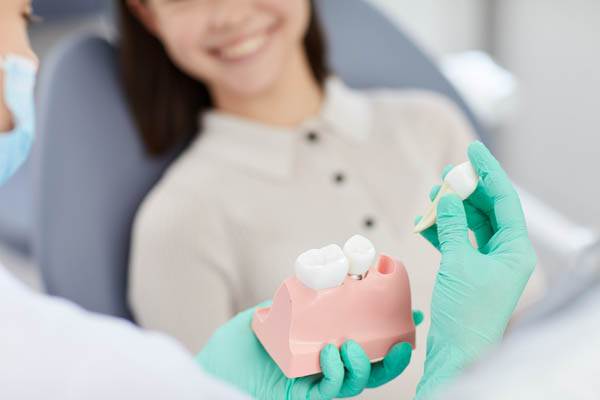Dental Bridges
An affordable aesthetic solution when you are missing one or two teeth
What is A Dental Bridge?
A dental bridge is a restoration that is used to fill the gap left after a tooth has been extracted. It has a false tooth in the centre, which constitutes the “bridge.” On either end of the bridge, we have a crown attached to the supporting tooth on either side of the missing tooth space, called abutment teeth.
The artificial teeth that make the bridge are called pontics, and the crowns on the two ends are called abutments. The entire assembly is made of porcelain material which is bonded to a metal layer underneath.
When are They used?
To fill the gap(s) created by one or more missing teeth
To fix a bite, thus helping with chewing and speaking problems
To maintain the jaw shape
To distribute chewing forces evenly in the mouth
To prevent drifting of other teeth around the gap


Types of dental bridges
Typically, three types of dental bridges are available at the dental clinic:
A traditional dental bridge: This is the most common type of dental bridge used. It consists of a pontic or false tooth in the middle, with two abutments or crowns on either end, cemented onto natural teeth (or implants) for support and retention. Traditional bridges can be placed either on the front or back teeth. They are generally made of porcelain bonded to metal.
Cantilever bridge: This type of dental bridge uses a crown only on one side of the bridge. It is used in situations where there are natural teeth present on only one side of the gap. Cantilever bridges are customarily used only for front teeth and are not preferred for back teeth since they cannot withstand heavy biting forces and may fracture.
Maryland bridge: This bridge is also called a resin-bonded bridge. It is similar to traditional dental bridges in terms of the false tooth or pontic. The only variation is that instead of using crowns for support, the Maryland bridge uses a metal or porcelain frame that attaches to the abutment teeth’ back surfaces.
Pros
- Easier on the pocket
- No surgery required
- Quick replacement for missing teeth
- Bone grafting not necessary
Cons
- Trimming of abutment teeth required
- Cannot treat bone loss
- It may not last as long as a dental implant (bridge lasts for 5-15 years)
Dental Implant
A dental implant is a superb alternative to a dental bridge. While a dental bridge uses support from the adjacent natural teeth to replace a missing tooth, a dental implant uses support from the jaw bone. For this reason, it is considered a permanent treatment. A dental bridge can last for 5-15 years depending on its taken care of, whereas a dental implant can possibly last for the entire lifetime. Dental implants are higher in price than dental bridges, so make sure you consider all your options and requirements before settling on a treatment.
Happy Patients
We always strive to ensure that all our patients leave us smiling
what Happens During a Dental Bridge Procedure?
multi appointment process
First appointment
- Our dentist will gauge the health of your teeth with a dental inspection and X-rays if necessary. We particularly pay attention to the teeth’ health on either side of the gap, as these will become supporting or abutment teeth for the bridge.
- The abutment teeth are trimmed and reshaped to get them ready to receive the crowns and bridge.
- Then, an impression of the gap and the trimmed abutment teeth is taken using a soft, moldable material.
- This impression will be forwarded to the lab for dental bridge fabrication.
- Meanwhile, our dentist will place a temporary crown on your teeth until the permanent comes in.
Second appointment
- We will remove your temporary bridge and fix the permanent bridge in its place with strong cement. The bridge will then be checked for proper fit, and we will make any last-minute corrections or adjustments, as needed.
- Our dentist will also teach you how to clean your dental bridge so that it lasts a long time.
Practice Plan
- Need Assistance?
frequently Asked Questions
A dental bridge fills the gaps formed by missing teeth. It consists of one or more artificial teeth in the centre, flanked by two crowns on either side that sit comfortably on abutment teeth. Abutment teeth are the teeth enveloping the gap.
The only way you can make your dental appliance last long is to maintain good oral hygiene practices. Similarly, a dental bridge can last anywhere between 5-15 years, depending on what kind of foods you eat, your risk for decay and your oral hygiene.
You can clean under your dental bridge using a floss threader, an interdental brush or a Waterpik. Instead of flossing between the teeth, the floss threader flosses under the dental bridge. An interdental brush operates similarly to remove food debris and bacteria that accumulate below the bridge. A Waterpik is a cleaning device that shoots tiny jets of water into the mouth’s hard-to-reach areas and cleans them effectively. Additionally, we recommend you go in for a professional tooth cleaning every six months to keep your dental bridge clean and health
A dental bridge should fit close to the gum line. There should not be any space between your bridge and the gums, as this acts as a reservoir for collecting food particles and bacteria, which are difficult to remove. Ensuring the correct fit will prevent you from developing gum disease.
A tooth bridge looks like a row of teeth that fills in gaps left by one or more missing teeth. It consists of two crowns on either end of the bridge and false teeth (called pontics) in the centre.
A dental bridge is a restorative treatment that works by filling in the gaps and replacing one or more missing teeth. The pontic or false tooth lies in the centre, while two abutments are present on either end. These attach to abutment teeth (supporting teeth) in the oral cavity and prevent dislodgement of the dental bridge.
Miriam Kenny Morehampton Dental Practice
Your Trusted Dental Clinic
- About Us
- COVID-19 Prepared
- Why Choose Us
Our practice is based on providing a high standard of modern dentistry in a friendly, professional manner. It is our mission to help our patients maintain their teeth and a healthy mouth for their lifetime.
Our entire team is committed to this ideal. As a result, a high percentage of our business is from returning patients and referrals of their family and friends. We welcome and are grateful for these referrals.

With the current Covid-19 pandemic we are paying particular attention to our normal cross-infection practices, but in addition, we are keeping the practice well ventilated (it may feel cold) and we use a special Fogging machine with Hypochlorous acid (HOCL) which is an all-natural antimicrobial agent made from salt and water by an electrolysis unit. Fogging of each surgery is carried out between patients after any treatment involving an aerosol.
To reduce aerosol production during procedures with the dentist we most often use a little device called a rubber dam —.50 this isolates the immediate teeth we are working with & protects the back of mouth. During hygienist treatment we are using an extra suction device outside of the mouth, this also reduces aerosol production.

The practice is owned & directed by Miriam Kenny and as the business owner and the principal healthcare professional, I am primarily interested in providing evidence-based dental healthcare. This means my priority is to help my dental patients to maintain their own natural teeth in a healthy mouth for their lifetime.
We can help improve your smile – we offer a range of options depending on what is most appropriate for you, from tooth whitening to composite bonding to ceramic veneers, crowns and bridges.

How Much do Dental Check-ups cost?
At Miriam Kenny Morehampton Dental Practice we aim to provide state of the art, quality affordable dental treatment to all.
It was with this in mind that we created our affordable dental plans, which helps us to keep your teeth, gums and oral health in tip-top shape.
With our Practice Plan, you will attend every 6 months with the hygienist and once yearly for your dental examination and have no fees to pay at these visits. The cost of these visits is covered by your monthly subscription – this is as low as €14.50 or €21, depending on whether you qualify for the “PRSI” benefit.
Other Treatments you may consider
There are numerous treatment options available for restoring a missing tooth. Each treatment has its pros and cons. Let’s look at some of them in detail
Permanent option for missing teeth. Implants are fixed into the bone, like natural teeth. After that, a dental crown is placed onto the implant to ensure your teeth look and comfort.




